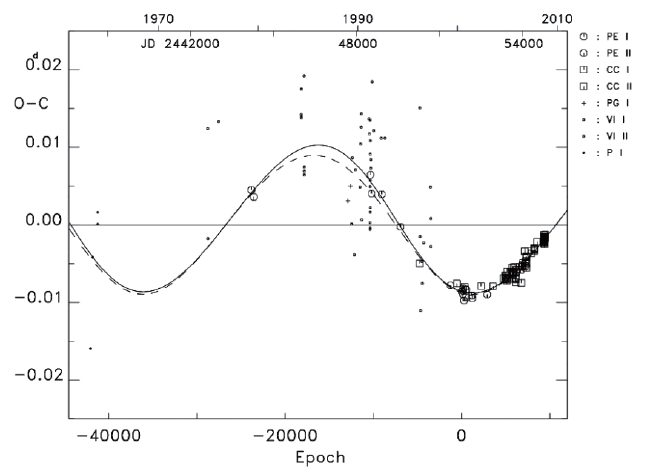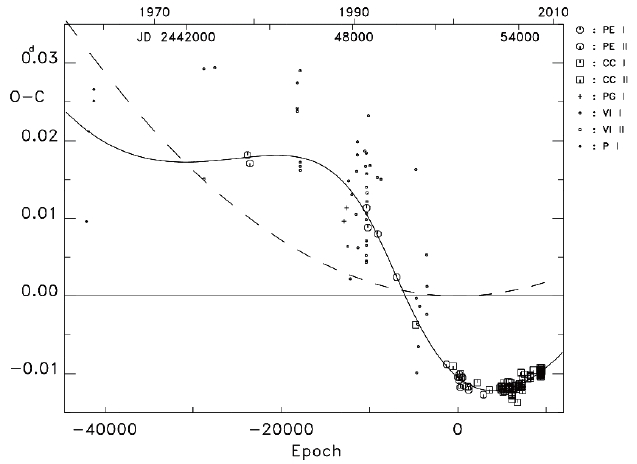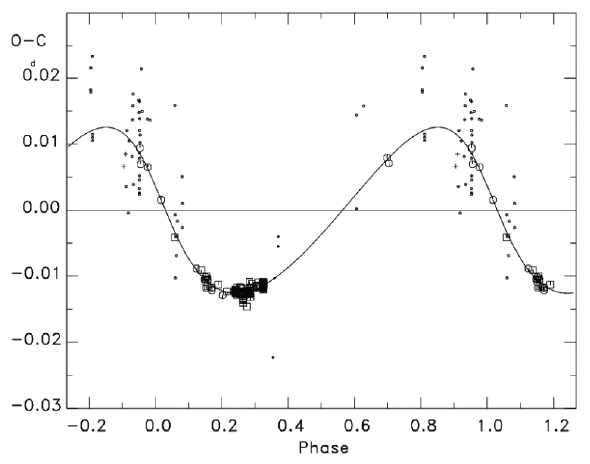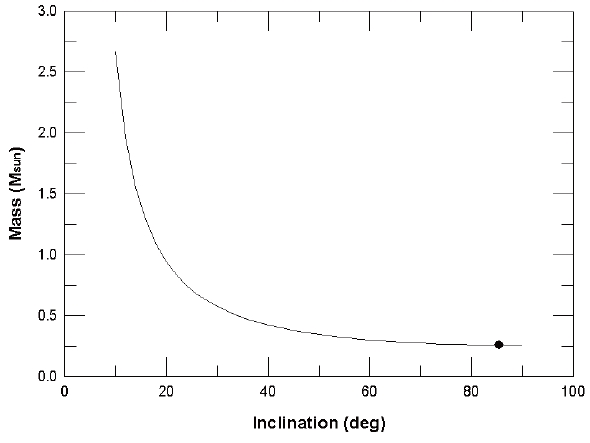



Period studies for the system have been carried out by Ragazzoni & Barbieri (1994, 1996), Pribulla et al. (2001a), Qian (2003), Chochol et al. (2006), and Lee et al. (2010). A secular decrease of period was first considered by Ragazzoni & Barbieri (1996) and later by Pribulla et al. (2001a), and Qian (2003). Chochol et al. (2006) suggested the possibility that the period of GW Cep may vary with either a single light-time effect (hereafter LITE) with a period of 32.6 years due to a tertiary body or a LITE with a short period of 13.5 years superposed on a downward parabola. Lee et al. (2010) showed that a single LITE with a period of 32.6 years would suffice to explain the period change of GW Cep with the latest measured and collected times of minima. The aim of this paper is to resolve the confusion regarding the period variation of the GW Cep system with new eclipse timing observations.
2. OBSERVATIONS AND DATA REDUCTION
The instrumentation and reduction method used for the raw CCD frames have been described in detail by Jeong et al. (2009). The resultant standard errors of our observations in terms of comparison minus check star were about ±0.m003 in blue, ±0.m009 in yellow and ±0.m021 in red, respectively. A total of 1,381 individual observations were obtained in three colors (469 in blue, 465 in yellow and 447 in red). New light curves are under analysis and will be published elsewhere. From our
For our study of the period variation of GW Cep, a total of 164 (46 visual, 4 sky patrol, 2 photographic, 16 photoelectric, and 95 CCD) times of minimum light were collected from a modern data-base (Kreiner et al. 2001) and from the recent literature. Table 1 lists all of the collected photoelectric and CCD minima. The minima marked by an asterisk in column 9 were determined with the consideration of two-spots model using the Wilson-Devinney binary code by Lee et al. (2010).
[Table 1.] Photoelectric and CCD times of minimum lights of GW Cep.
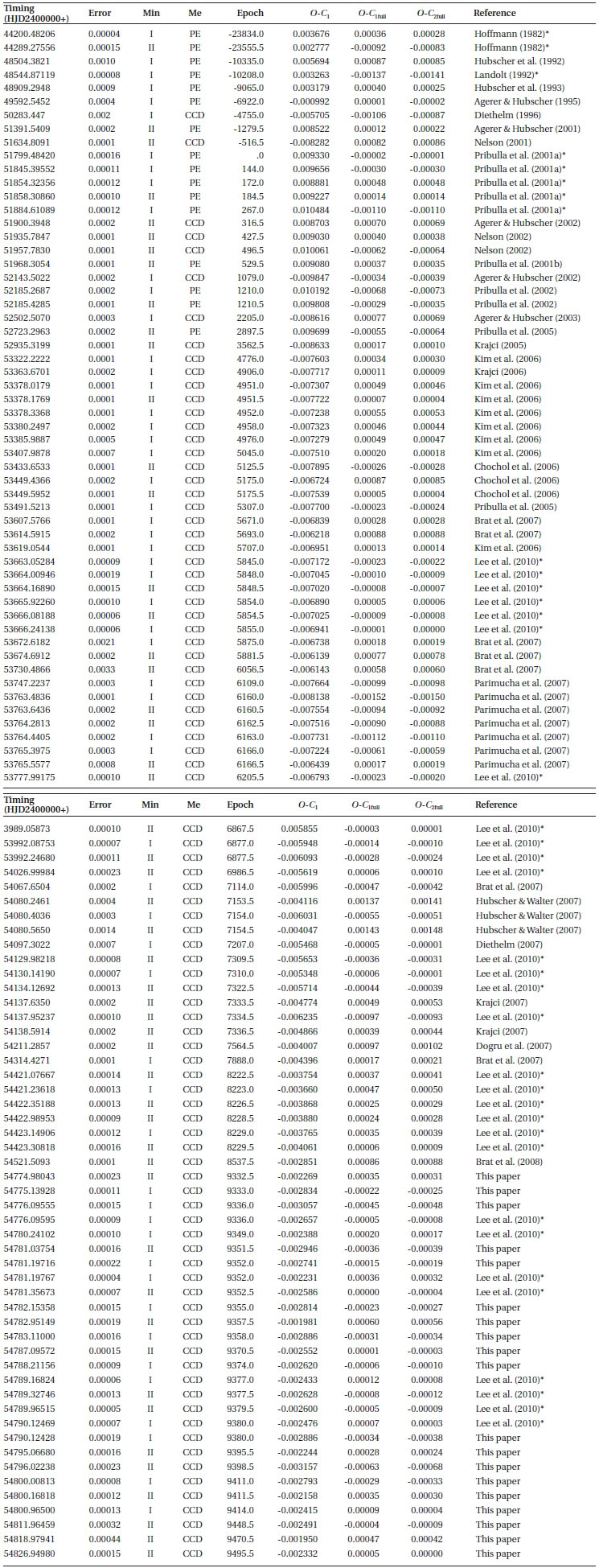
Photoelectric and CCD times of minimum lights of GW Cep.
[Table 2.] The derived LITE and secular ephemerides for GW Cep.
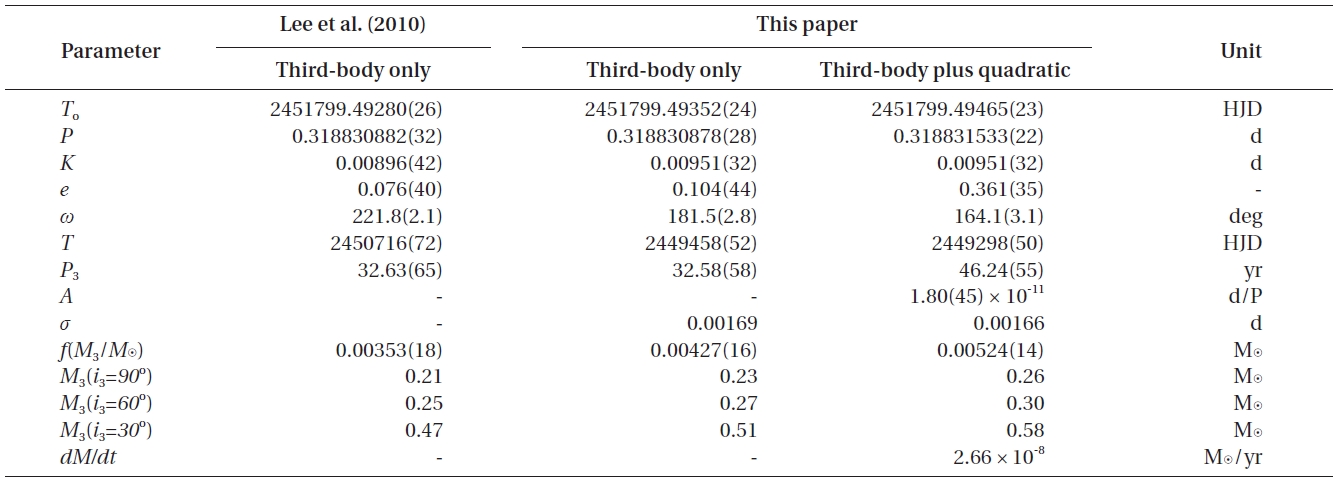
The derived LITE and secular ephemerides for GW Cep.
Before our subsequent analysis of the times of minimum light, most of the timings were weighted according to the inversely-squared values of their published internal errors. As seen in Table 1, all photoelectric and CCD minima have errors. Among the previous 52 non-photoelectric and non-CCD timings not listed in Table 1, there were 29 minima without errors. These minima were assigned an inversely-squared weight of their standard deviation of ±0.0068 d, reasonably given by Lee et al. (2010).
With the weight system above, all times of minima were separately fitted to a LITE ephemeris with and without a quadratic term, respectively, as follows:
and
where τ is the light-time term with a parametric form taken from Irwin (1952, 1959). The Levenberg-Marquardt method (Press et al. 1992) was used to solve the parameters of Equations (2) and (3). The solution converged quickly, and the results are listed in Table 2 together with those of Lee et al. (2010), wherein the parenthesized values give the standard errors of the tabulated quantities. The σ values in the ninth row of Table 2 denote the weighted standard deviations of residuals from all terms in Equations (2) and (3). These values fit Equation (3) slightly better than Equation (2). The solid line in Figure 1 was drawn using our single LITE orbital elements in the third column of Table 2. The parameters of Lee et al. (2010) were slightly modified with the inclusion of our latest timings. The (O-C1) and (O-C1full) residuals calculated with the linear term and the full terms of Equation (3) are listed in the sixth and seventh columns of Table 1, respectively. The LITE elements derived with Equation (3) in the fourth column of Table 2, however, are quite different from both Lee et al.’s (2010) and our single LITE, especially the larger eccentricity of 0.36 and the longer period of 46.2 yr. The residuals from the linear term of Equation (3) were drawn in Figure 2 using the parabolic and cyclical components fitting to (O-C2) residuals. The
(O-C2full) residuals from all terms are listed in the eighth column of Table 1. Figure 3 shows the O-C residuals from the linear and parabolic terms and the theoretical LITE curve phased with the third-body ephemeris of Table 2.
The 46.2 yr cyclic component of the period variability that appears to be present in the data set could be explained by either a LITE or an Applegate model, as discussed above. The latter interpretation is a possible mechanism explaining the apparent cyclic period change, because the two late-type stars in GW Cep could have strong magnetic activity and an activity cycle (Guinan & Gimenez 1993) and strong light variations as intensively analyzed by Lee et al. (2010). However, because of insufficient light-curve data, it may not be possible to check whether the overall brightness of GW Cep has varied in the same way as the period change, which is what the Applegate model requires. In this case, the length of the activity cycle would be about 46 yr. The LITE interpretation for the cyclic component with an eccentric orbit (e = 0.36) gave a mass function f (m/M⊙) of 0.00524 for the LITE orbit. To estimate the mass of the third body, the mass function was solved as a function of the orbital inclination of the third body. A diagram of mass versus inclination in Fig. 4 shows a minimum mass of 0.26 M⊙ for the hypothetical tertiary body. At the moment, however, there are no other observations that support the third-body hypothesis. If the minimum mass of 0.26 M⊙ is adopted and the tertiary is assumed to be a main-sequence star, it would be a dM star with a low luminosity of 0.007 L⊙ (see also Lee et al. 2010).
The parabolic component of the period change of GW Cep corresponds to a secular period increase of +4.12 × 10-8 d/yr and implies a mass transfer of 2.66 × 10-8 M⊙/yr from the less massive to the more massive star, that is, if the mass and angular momentum of the system are conserved and the masses for the eclipsing stars of Mh = 0.39 M⊙ and Mc = 1.06 M⊙ given by Maceroni & van’t Veer (1996) are used. The mass transfer rate in the GW Cep system is moderate and is similar to the rates provided by YY Eri (Kim et al. 1997) and V432 Per (Lee et al. 2008).
Nineteen new times of minima of GW Cep were determined from the
In conclusion, the apparent secondary variation of GW Cep’s period varies in a sinusoidal way, superposed on the long-term upward parabolic variation. The secularly increasing rate of the period is deduced to be 0.36 s per century (+4.12×10-8 d/yr), implying a mass transfer of 2.66×10-8 M⊙/yr from the less massive to the more massive star for the conservative case. The mass transfer may be a possible cause of the hot spot near the neck of the facing hemisphere of the cooler, more massive star, which was consistently found in the light curve synthesis by Lee et al. (2010). The period of the quasi-sinusoidal variation is about 46.2 yr. This period could arise from a LITE due to the gravitational effect of a third body or from a cyclic period modulation due to the magnetically active component stars. The tertiary body was deduced to be a low-mass (m3=0.26 M⊙ sin i) and a low luminosity luminosity (L3=0.007L⊙) dM companion moving in an eccentric (e=0.36) orbit. However, there were no other observations supporting the tertiary body model. Although the historical light-curve variations indicate star-spots and possible high levels of magnetic dynamo activity, the possibility that the 46.2-yr periodicity arises from the varying magnetic activity of the stars seems unlikely, according to Lee et al.’s (2010) intensive investigation on that matter. At the same time, the dynamical picture of GW Cep is far from reality. The obvious way to try to further understand GW Cep is to obtain more data of all kinds to determine the following: magnetodynamic activity (e.g., cyclic effects in emission lines, maculation effects in the photometry, or radio or other EUVE and X-ray data); and other third-body effects (e.g., cyclic variations of gamma velocity, third-body spectrum in high resolution spectroscopy, detection of any third light in high precision photometry, or cyclic position-changes in astrometry).
